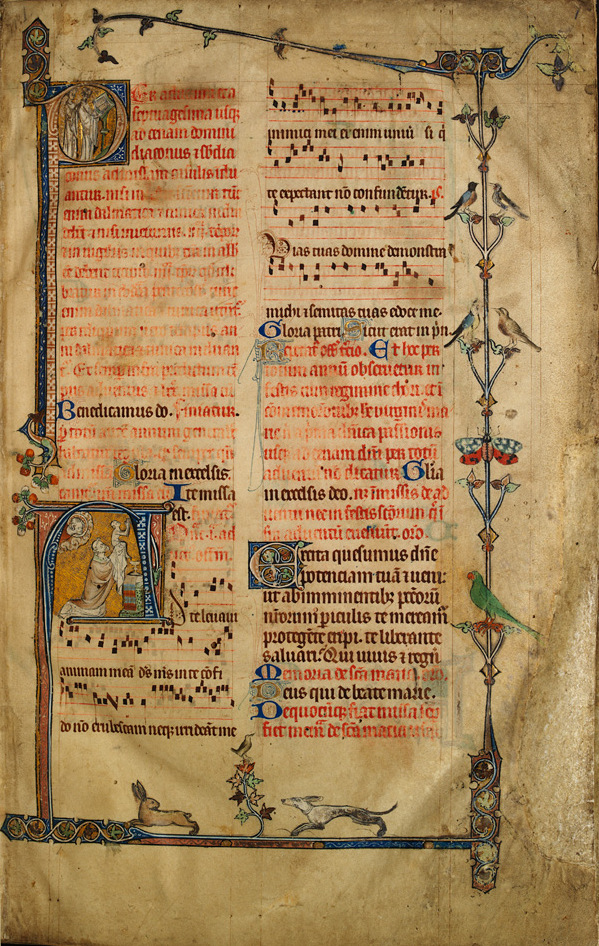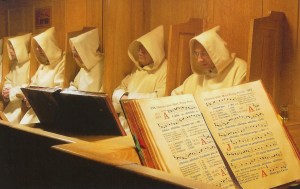Text and Illustrations from Wikipedia - the free encyclopaedia,
unless otherwise stated.
The Interior of Saint Mary The Virgin,
Wellingborough, Northamptonshire, England.
Sir John Ninian Comper designed this Church.
The spectacular Interior of Saint Mary's, Wellingborough, Northamptonshire, England.
The Church is little more than a Century old and was designed by the highly-regarded
architect,
Sir Ninian Comper. The Church is extremely ornate, but never vulgar, and
the Golds and Blues
blend in perfectly well with the local Deep-Golden Stone.
The Church is in the Anglo-Catholic Tradition
of The Church of England.
Photo: 18 August 1997.
Source: From geograph.org.uk.
Author: nick macneill.
(Wikimedia Commons)
Sir John Ninian Comper (1864–1960) was a Scottish-born architect. He was one of the last of the great Gothic Revival architects, noted for his Churches and their furnishings. He is well known for his Stained Glass, his use of colour and his subtle integration of Classical and Gothic elements, which he described as "unity by inclusion".
Comper was born in Aberdeen, Scotland, the eldest of five children of Ellen Taylor, of Hull, and the Reverend John Comper, Rector of St John's, Aberdeen (and, later, St Margaret of Scotland). He was educated at Glenalmond School, in Perthshire, and attended a year at the Ruskin School of Art in Oxford. On moving to London, he was Articled to Charles Eamer Kempe, and, later, to George Frederick Bodley and Thomas Garner. His fellow-Scot, William Bucknall, took him into partnership in London in 1888 and Ninian was married to Grace Bucknall in 1890. Bucknall and Comper remained in partnership until 1905.
Reredos, in Wymondham Abbey, Norfolk, England, designed by Comper.
Reredos (Altar Screen), with Tester and Rood Figures, designed by Sir Ninian Comper, 1922.
Photographer: Richard Barton-Wood.
Date: 1922 (object created); 27 February 2007 (original upload date).
Source: Transferred from en.wikipedia; transferred to
Commons using CommonsHelper.
Author: Sir Ninian Comper (creator of the object);
Photographer and Original uploader was Richard Barton-Wood.
(Wikimedia Commons)
Sir John Ninian Comper's ecclesiastical commissions include:
A line of windows in the North Wall of The Nave of Westminster Abbey;
Saint Peter's Parish Church, Huddersfield, Yorkshire, the Baldachino/Ciborium, High Altar and
East Window, in memory of The Dead of The Great War;
Saint Mary's, Wellingborough;
Saint Michael and All Angels, Inverness;
Lady Chapel at Downside Abbey,Somerset;
The Ciborium, and House Chapel extension, for The Society of Saint John the Evangelist, in Oxford (now Saint Stephen's House, Oxford);
Saint Cyprian's, Clarence Gate, London;
Lady Chapel at Saint Matthew's, Westminster;
Lady Chapel and Gilded Paintings in the Chancel of All Saints, Margaret Street, London.
The Sanctuary,
All Saints Church,
Margaret Street, London.
One of Sir John Ninian Comper's commissions.
Photo: 3 November 2001.
Source: From geograph.org.uk; transferred by
Author: John Salmon.
(Wikimedia Commons)
Comper is noted for re-introducing the "English Altar", an Altar surrounded by Riddel Posts. [Images, and documentary mentions of early examples [of Ciboria], often have Curtains, called tetravela, hung between the Columns; these Altar-Curtains were used to cover, and then reveal, the view of the Altar by the Congregation at points during Services — exactly which points varied, and is often unclear. Altar-Curtains survived the decline of the Ciborium in both East and West, and in English are often called "Riddels" (from French, rideau, a word once also used for ordinary domestic curtains).
Charles Eamer Kempe, (1860).
Upon moving to London, John Ninian Comper was Articled to Charles Eamer Kempe.
Charles Eamer Kempe (29 June 1837 – 29 April 1907) was a Victorian Stained Glass designer and manufacturer. His studios produced over 4,000 windows and also designs for Altars and Altar Frontals, furniture and furnishings, Lichgates and Memorials, that helped to define a later 19th-Century Anglican style. The list of English Cathedrals containing examples of his work includes: Chester, Gloucester, Hereford, Lichfield, Wells, Winchester, York.
This File: 21 July 2006.
User: The Wednesday Island.
Source: Found at [http://homepage.ntlworld.com/peter.fairweather/docs/kempe.htm].
Author: Unknown.
(Wikipedia)
A few Churches have "Riddle Posts", or "Riddel Posts", around The Altar, which supported The Curtain-Rails, and perhaps a Cloth stretched above. Such an arrangement can be seen in Folio 199v of the Très Riches Heures du duc de Berry. Late-Mediaeval examples in Northern Europe were often topped by Angels, and the Posts, but not the Curtains, were revived in some new or refitted Anglo-Catholic Churches by Ninian Comper and others around 1900.
Altar Frontal (Antependium) designed by Charles Eamer Kempe.
Upon moving to London, John Ninian Comper was Articled to Charles Eamer Kempe.
Illustration: MEDIEVAL CHURCH ART
Altar Frontal (Antependium) designed by Charles Eamer Kempe.
Upon moving to London, John Ninian Comper was Articled to Charles Eamer Kempe.
Illustration: MEDIEVAL CHURCH ART
Altar Frontal (Antependium) designed by Charles Eamer Kempe.
Upon moving to London, John Ninian Comper was Articled to Charles Eamer Kempe.
Illustration: MEDIEVAL CHURCH ART
Altar Frontal (Antependium) designed by Charles Eamer Kempe.
Upon moving to London, John Ninian Comper was Articled to Charles Eamer Kempe.
Illustration: MEDIEVAL CHURCH ART
In earlier periods, the Curtains were closed at the most Solemn part of The Mass, a practice that continues to the present day in The Coptic and Armenian Churches. A comparison to the Biblical Veil of The Temple was intended. The small domed structures, usually with Red Curtains, that are often shown near The Writing Saint in early Evangelist portraits, especially in the East, represent a Ciborium, as do the structures surrounding many manuscript portraits of Mediaeval Rulers.]
English: Saint John the Baptist Parish Church, Cardiff, Wales. Stained-Glass Window (1915)
by Ninian Comper: Saint Luke painting Madonna and Child (detail).
Deutsch: Cardiff (Wales). Pfarrkirche St. Johannes der Täufer - Buntglasfenster (1915)
von Ninian Comper: Heiliger Lukas malt Madonna mit Kind (Detail).
Photo: 28 July 2011.
Source: Own work.
Author: Wolfgang Sauber.
(Wikimedia Commons)
Comper designed a number of remarkable Altar Screens (Reredos), inspired by Mediaeval originals. Wymondham Abbey, Norfolk, has one of the finest examples.
Only one major ecclesiastical work of Comper's is in The United States, the Leslie Lindsey Chapel of Boston's Emmanuel Episcopal Church. The work is an all-encompassing product of, and testimony to, Comper's design capability, comprising the entire decorative scheme of the Chapel, designed by the architectural firm of Allen and Collins. Comper designed its Altar, Altar Screen, Pulpit, Lectern, dozens of statues, all its furnishings and appointments, and most notably the Stained-Glass Windows. The Chapel commemorates Leslie Lindsey and Stewart Mason, her husband of ten days, who were married at Emmanuel Church, and perished when the Lusitania was torpedoed in 1915.
Detail of Reredos at Saint James Church,
High Melton, England, by Ninian Comper.
Photo: 27 July 2007.
Source: Own work.
Author: Dearnesman.
(Wikimedia Commons)
Sir John Ninian Comper's Rood Screen,
Saint John the Baptist Church,
Lound, Nottinghamshire, England.
Photo: 24 September 2009.
Source: From geograph.org.uk.
Author: Evelyn Simak.
(Wikimedia Commons)
Saint John the Baptist's Church 1507412 - 1507426 , in Lound, is widely known as the 'Golden Church', its fame originating from the generosity of Father Booth Lyes, a past Rector, who employed Sir Ninian Comper's genius to restore it. The Round Tower 1507419 - the oldest part of the Church and believed to be Early-Norman - was probably rebuilt at some later time. The Church was extensively restored in 1912/1913. The High Altar 1507434 was raised on new flooring, and richly decorated Posts, surmounted by gilded bronze Angels, support curtains of Spanish silk.
Below the Altar, Ninian Comper's magnificent Rood Screen is adjoined at the South End by The Altar of Our Lady, above which Saint Mary Salome, Saint Mary The Virgin, and Saint Elizabeth, are depicted on boards with richly gilded gesso backgrounds 1507432. By Comper, is also the only modern wall painting in Suffolk depicting a Saint Christopher 1507439 - the Saint is surrounded by a water mill, with a Suffolk Punch horse and its rider, waiting patiently in front of it, and a portrait of Sir Ninian driving his Rolls Royce along the river bank. The airplane, at top right, was added during the 1964 restoration of the painting.
The Organ Case 1507447, at the West End of the Church, was installed in 1913. The Organ was built by Harrison and Harrison Ltd, of Durham. The original Norman Font Bowl now serves as a base for the Pulpit. The present Octagonal Font 1507445 - given in 1389 by Robert Bertelot - is of the Traditional East Anglian type and the inscription at its base, commemorating the donor, is still legible. Saint John the Baptist's Church has a 'Welcome' banner above the South Doorway and is open every day.
Saint Mary The Virgin Church,
Wellingborough, Northamptonshire, England.
One of Sir John Ninian Comper's masterpieces of creation.
Illustration: ST MARY THE VIRGIN, WELLINGBOROUGH
From 1912, Ninian and Grace lived in London at The Priory, Beulah Hill, a house designed by Decimus Burton (1800–1881), where he entertained friends such as John Betjeman. He had a studio nearby at Knights Hill, close to the world's first Gothic Cemetery at West Norwood. After the studio was destroyed in World War II, it was relocated to a building in his garden, which had previously been used by his son, Nicholas Comper (1897–1939), to design aircraft. Comper was Knighted by King George VI in 1950.
On 22 December 1960, he died in The Hostel of God (now Trinity Hospice) in Clapham, London. His body was brought back to Norwood for cremation at West Norwood Cemetery. His ashes were then interred beneath the windows he designed in Westminster Abbey.


























